行为动词的一般现在时
- 格式:doc
- 大小:92.00 KB
- 文档页数:4
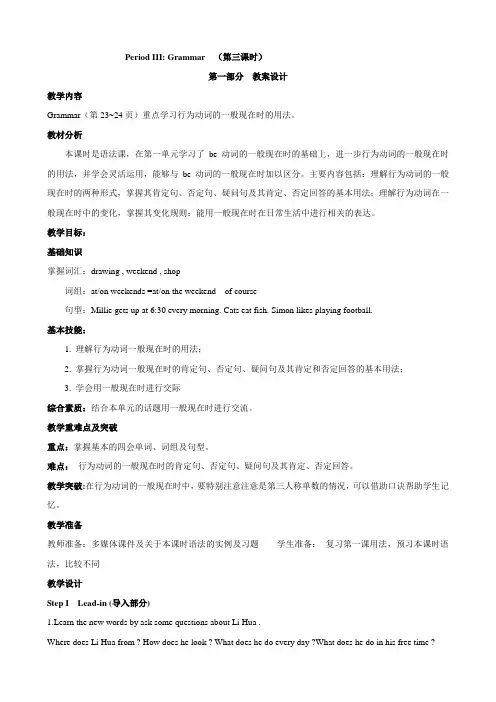
Period III: Grammar (第三课时)第一部分教案设计教学内容Grammar(第23~24页)重点学习行为动词的一般现在时的用法。
教材分析本课时是语法课,在第一单元学习了be动词的一般现在时的基础上,进一步行为动词的一般现在时的用法,并学会灵活运用,能够与be动词的一般现在时加以区分。
主要内容包括:理解行为动词的一般现在时的两种形式,掌握其肯定句、否定句、疑问句及其肯定、否定回答的基本用法;理解行为动词在一般现在时中的变化,掌握其变化规则;能用一般现在时在日常生活中进行相关的表达。
教学目标:基础知识掌握词汇:drawing , weekend , shop词组:at/on weekends =at/on the weekend of course句型:Millie gets up at 6:30 every morning. Cats eat fish. Simon likes playing football.基本技能:1. 理解行为动词一般现在时的用法;2. 掌握行为动词一般现在时的肯定句、否定句、疑问句及其肯定和否定回答的基本用法;3. 学会用一般现在时进行交际综合素质:结合本单元的话题用一般现在时进行交流。
教学重难点及突破重点:掌握基本的四会单词、词组及句型。
难点:行为动词的一般现在时的肯定句、否定句、疑问句及其肯定、否定回答。
教学突破:在行为动词的一般现在时中,要特别注意注意是第三人称单数的情况,可以借助口诀帮助学生记忆。
教学准备教师准备:多媒体课件及关于本课时语法的实例及习题学生准备:复习第一课用法,预习本课时语法,比较不同教学设计Step I Lead-in (导入部分)1.Learn the new words by ask some questions about Li Hua .Where does Li Hua from ? How does he look ? What does he do every day ?What does he do in his free time ?2. Look ,who are these men in the picture? They are basketball players. They play basket very well. This is Kobe .He looks very strong. Kobe plays basketball very well. Many students like him. They often watch his game on TV in their free time. I like watching TV too. But my cousin likes reading .He often reads storybooks.Look at these sentences pay attention to the verbs. We use the Verb” to be” in the these three sentences while we use the verb” to do in these ones. Today we’ll learn the simple present tense of the verb to do.Step ⅡPresentation(新授)1. Complete the sentences using the simple present tense of the verb to do .He often _________(play) football after school .She __________(like) playing volleyball .It ________(look) like a cat .We ___________(enjoy) reading very much .They usually ___________(get) up at 6:00 in the morning .You _________(like) sports .2. Explain the use of the simple present tense of the verb to do. Open your books at page 23 and read the sample sentences .3. Can you find the different forms of the verb to do in these sentences ?When the subject is he/ she / it , we need to add an “s” to the verb .Do you want to know how to add an “s” to the verb ? Let’s read the table on page 23 together . How many ways are there to add an “s” ? What are they ?写出动词的第三人称单数形式put __________ enjoy_________ write ______ fly __________play___________ have_____________ guess _________ match ________go_________ do _________________ study _______ stay ____________4. Millie is writing about herself and her classmates. Please help her complete the sentences in part A with the words in the box.Now who can read the sentences to us ?other listen carefully and check the answers. Finish Part A .Step ⅢPractice(操练)1. Do you know how to make negative sentences and ask and answer questions using the verb to do in the simple present tense ? OK , change the sentences on the board into negative sentences and ask and answer questions .2. Now let’s read the tables on page 23 together .3. Finish Part B on page 24 .4. Look at the table on page 24 and work in pairs, look at this table .It tells us the activities Millie and herclassmates like. Please complete the questions in Part B and then use the information in the table to answer them. Does Daniel like walking ? Yes , he does .Do Amy and Sandy enjoy reading ?Yes ,they do .Does Daniel like drawing ? No , he doesn’t .Do Millie and Kitty enjoy swimming ? No , they don’t .5. Finish Part C6. Explain some language points : at/ on weekends = at/on the weekend of course .7. Work in pairs .教材习题英语书第24页,Part A : 1 like 2 dances 3 goes 4 plays 5 watchesPart B :1 Do; Yes, they do. 2 Does; No she doesn’t.3Does; Yes, she does.4 Does; No, he doesn’t. 5 Do; No, they don’t.Part C Keys: 1 Do, play 2 play 3 Do, go 4 watches 5 reads 6 shops 7 stay 8 go随堂小练习I.用所给动词的适当形式填空。

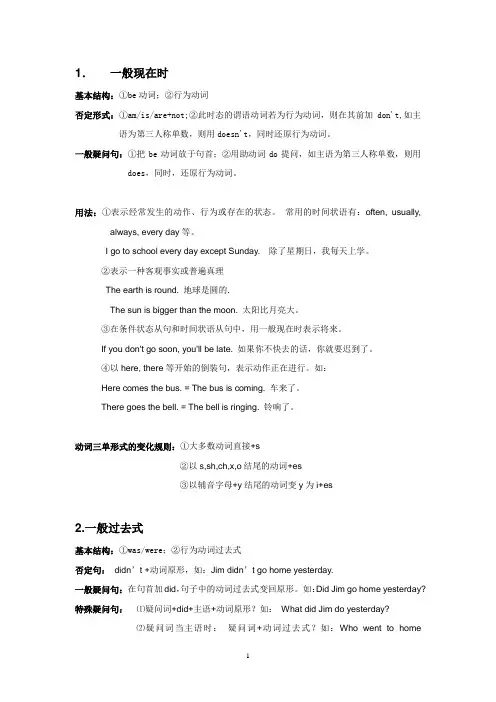
1.一般现在时基本结构:①be动词;②行为动词否定形式:①am/is/are+not;②此时态的谓语动词若为行为动词,则在其前加don't,如主语为第三人称单数,则用doesn't,同时还原行为动词。
一般疑问句:①把be动词放于句首;②用助动词do提问,如主语为第三人称单数,则用does,同时,还原行为动词。
用法:①表示经常发生的动作、行为或存在的状态。
常用的时间状语有:often, usually, always, every day等。
I go to school every day except Sunday. 除了星期日,我每天上学。
②表示一种客观事实或普遍真理The earth is round. 地球是圆的.The sun is bigger than the moon. 太阳比月亮大。
③在条件状态从句和时间状语从句中,用一般现在时表示将来。
If you don't go soon, you'll be late. 如果你不快去的话,你就要迟到了。
④以here, there等开始的倒装句,表示动作正在进行。
如:Here comes the bus. = The bus is coming. 车来了。
There goes the bell. = The bell is ringing. 铃响了。
动词三单形式的变化规则:①大多数动词直接+s②以s,sh,ch,x,o结尾的动词+es③以辅音字母+y结尾的动词变y为i+es2.一般过去式基本结构:①was/were;②行为动词过去式否定句:didn’t +动词原形,如:Jim didn’t go home yesterday.一般疑问句:在句首加did,句子中的动词过去式变回原形。
如:Did Jim go home yesterday? 特殊疑问句:⑴疑问词+did+主语+动词原形?如:What did Jim do yesterday?⑵疑问词当主语时:疑问词+动词过去式?如:Who went to homeyesterday动词过去式的构成规则:(1)规则动词过去式的构成有四条规则:①一般在动词原形末尾直接加上-ed。
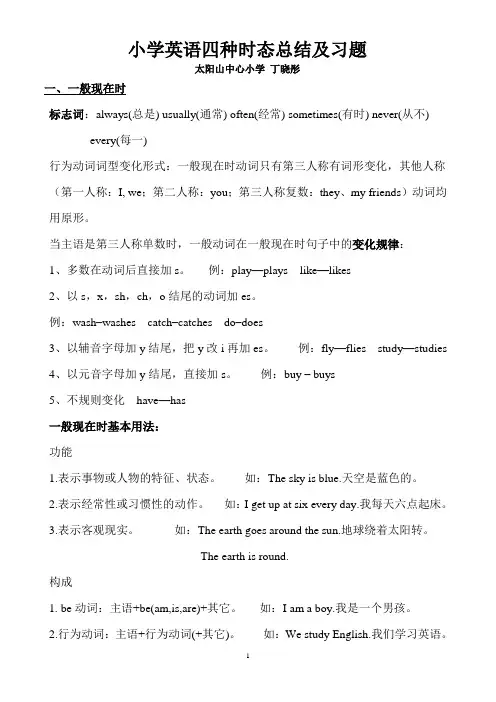
小学英语四种时态总结及习题太阳山中心小学丁晓彤一、一般现在时标志词:always(总是) usually(通常) often(经常) sometimes(有时) never(从不) every(每一)行为动词词型变化形式:一般现在时动词只有第三人称有词形变化,其他人称(第一人称:I, we;第二人称:you;第三人称复数:they、my friends)动词均用原形。
当主语是第三人称单数时,一般动词在一般现在时句子中的变化规律:1、多数在动词后直接加s。
例:play—plays like—likes2、以s,x,sh,ch,o结尾的动词加es。
例:wash–washes catch–catches do–does3、以辅音字母加y结尾,把y改i再加es。
例:fly—flies study—studies4、以元音字母加y结尾,直接加s。
例:buy – buys5、不规则变化have—has一般现在时基本用法:功能1.表示事物或人物的特征、状态。
如:The sky is blue.天空是蓝色的。
2.表示经常性或习惯性的动作。
如:I get up at six every day.我每天六点起床。
3.表示客观现实。
如:The earth goes around the sun.地球绕着太阳转。
The earth is round.构成1. be动词:主语+be(am,is,are)+其它。
如:I am a boy.我是一个男孩。
2.行为动词:主语+行为动词(+其它)。
如:We study English.我们学习英语。
句型肯定句:A. be动词:主语+ be + 其它成分如:He is a worker.B.行为动词:主语+动词(注意人称变化) +其它成分如:We like the little cat.否定句:A. be动词:主语+ be + not +其它成分如:They are not students.B.行为动词:主语+助动词(do/does) + not +动词原形+其它成分如:We don’t like the little cat.一般疑问句:A. be动词:Am / Is /Are +主语+ 其它成分如:Are you a teacher? Yes, I am. / No, I am not.Are they students of your school?Yes they are / No they aren’t.B.行为动词:助动词(Do/Does)+主语+动词原形+ 其它成分如:Do you like it? Yes, I do. / No. I don’t .Does he(she) like it? Yes, he( she )does. / No, he ( s he )doesn’t.特殊疑问句:疑问词+ 一般疑问句A. be动词:How many students are there in your school?B.行为动词:What do you usually do on Sunday?一般现在时动词be和have的变化形式1.动词Be 用法:第一人称单数用am,第三人称单数用is,其它人称用are。
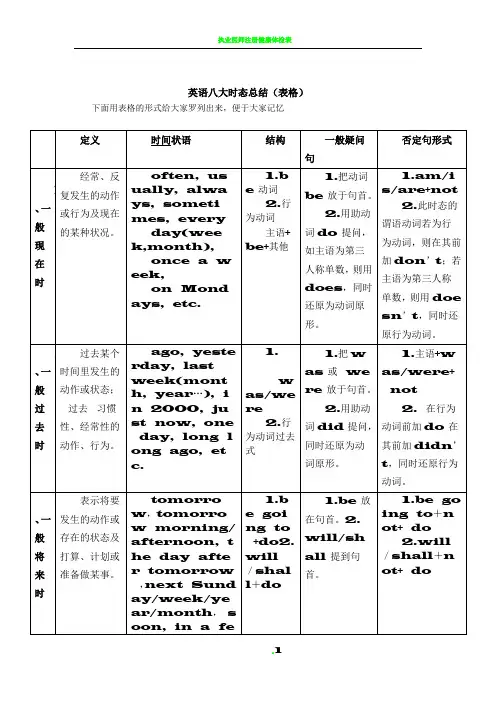
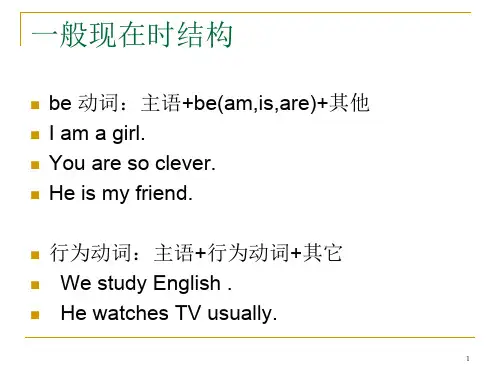
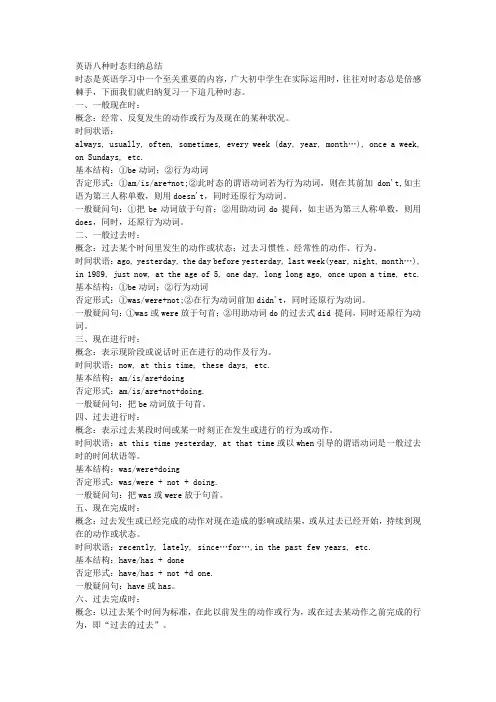
英语八种时态归纳总结时态是英语学习中一个至关重要的内容,广大初中学生在实际运用时,往往对时态总是倍感棘手,下面我们就归纳复习一下這几种时态。
一、一般现在时:概念:经常、反复发生的动作或行为及现在的某种状况。
时间状语:always, usually, often, sometimes, every week (day, year, month…), once a week, on Sundays, etc.基本结构:①be动词;②行为动词否定形式:①am/is/are+not;②此时态的谓语动词若为行为动词,则在其前加don't,如主语为第三人称单数,则用doesn't,同时还原行为动词。
一般疑问句:①把be动词放于句首;②用助动词do提问,如主语为第三人称单数,则用does,同时,还原行为动词。
二、一般过去时:概念:过去某个时间里发生的动作或状态;过去习惯性、经常性的动作、行为。
时间状语:ago, yesterday, the day before yesterday, last week(year, night, month…), in 1989, just now, at the age of 5, one day, long long ago, once upon a time, etc. 基本结构:①be动词;②行为动词否定形式:①was/were+not;②在行为动词前加didn't,同时还原行为动词。
一般疑问句:①was或were放于句首;②用助动词do的过去式did 提问,同时还原行为动词。
三、现在进行时:概念:表示现阶段或说话时正在进行的动作及行为。
时间状语:now, at this time, these days, etc.基本结构:am/is/are+doing否定形式:am/is/are+not+doing.一般疑问句:把be动词放于句首。
四、过去进行时:概念:表示过去某段时间或某一时刻正在发生或进行的行为或动作。
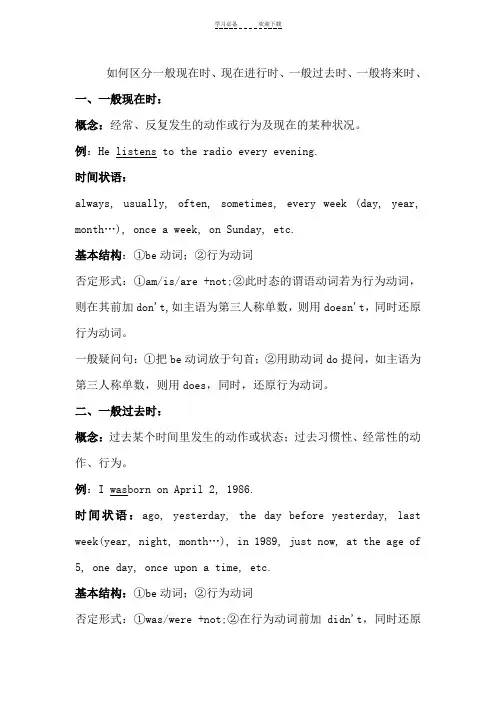
如何区分一般现在时、现在进行时、一般过去时、一般将来时、一、一般现在时:概念:经常、反复发生的动作或行为及现在的某种状况。
例:He listens to the radio every evening.时间状语:always, usually, often, sometimes, every week (day, year, month…), once a week, on Sunday, etc.基本结构:①be动词;②行为动词否定形式:①am/is/are +not;②此时态的谓语动词若为行为动词,则在其前加don't,如主语为第三人称单数,则用doesn't,同时还原行为动词。
一般疑问句:①把be动词放于句首;②用助动词do提问,如主语为第三人称单数,则用does,同时,还原行为动词。
二、一般过去时:概念:过去某个时间里发生的动作或状态;过去习惯性、经常性的动作、行为。
例:I wasborn on April 2, 1986.时间状语:ago, yesterday, the day before yesterday, last week(year, night, month…), in 1989, just now, at the age of 5, one day, once upon a time, etc.基本结构:①be动词;②行为动词否定形式:①was/were +not;②在行为动词前加didn't,同时还原行为动词。
一般疑问句:①was或were放于句首;②用助动词do的过去式did 提问,同时还原行为动词。
三、现在进行时:概念:表示现阶段或说话时正在进行的动作及行为。
时间状语:at the monment look listen\now例:The woman is talking to the doctor.时间状语:now, at this time, these days, etc.基本结构:am /is/are +doing否定形式:am /is/are +not +doing.一般疑问句:把be动词放于句首。
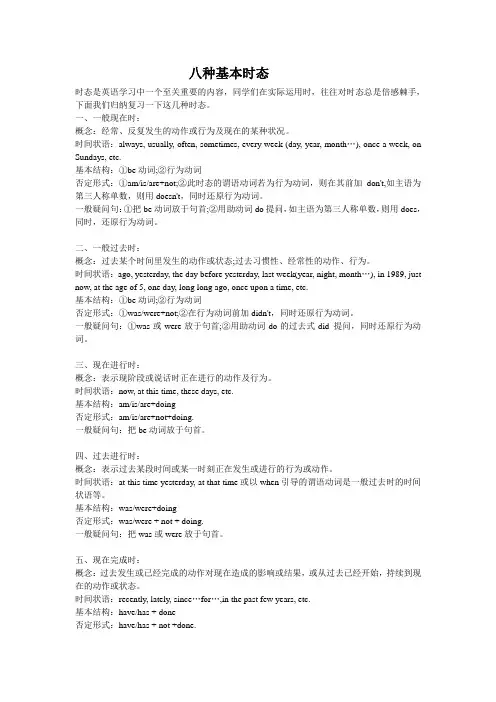
八种基本时态时态是英语学习中一个至关重要的内容,同学们在实际运用时,往往对时态总是倍感棘手,下面我们归纳复习一下这几种时态。
一、一般现在时:概念:经常、反复发生的动作或行为及现在的某种状况。
时间状语:always, usually, often, sometimes, every week (day, year, month…), once a week, on Sundays, etc.基本结构:①be动词;②行为动词否定形式:①am/is/are+not;②此时态的谓语动词若为行为动词,则在其前加don't,如主语为第三人称单数,则用doesn't,同时还原行为动词。
一般疑问句:①把be动词放于句首;②用助动词do提问,如主语为第三人称单数,则用does,同时,还原行为动词。
二、一般过去时:概念:过去某个时间里发生的动作或状态;过去习惯性、经常性的动作、行为。
时间状语:ago, yesterday, the day before yesterday, last week(year, night, month…), in 1989, just now, at the age of 5, one day, long long ago, once upon a time, etc.基本结构:①be动词;②行为动词否定形式:①was/were+not;②在行为动词前加didn't,同时还原行为动词。
一般疑问句:①was或were放于句首;②用助动词do的过去式did 提问,同时还原行为动词。
三、现在进行时:概念:表示现阶段或说话时正在进行的动作及行为。
时间状语:now, at this time, these days, etc.基本结构:am/is/are+doing否定形式:am/is/are+not+doing.一般疑问句:把be动词放于句首。
四、过去进行时:概念:表示过去某段时间或某一时刻正在发生或进行的行为或动作。
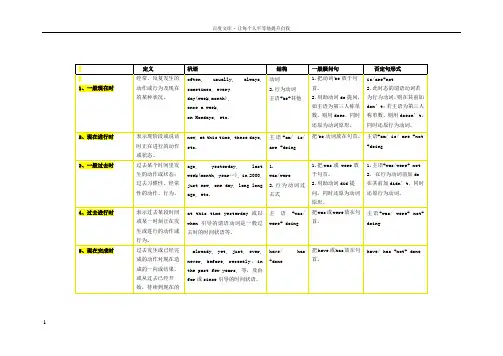

(一)一般现在时定义:经常、反复发生的动作或行为及现在的某种状况。
时间状语:often, usually, always, sometimes, everyday(week,month),once a week,on Mondays, etc.结构:1.be动词2.行为动词主语+be+其他一般疑问句:1.把动词be放于句首。
2.用助动词do提问,如主语为第三人称单数,则用does,同时还原为动词原形。
否定句形式:1.am/is/are+not2.此时态的谓语动词若为行为动词,则在其前加d on’t;若主语为第三人称单数,则用doesn’t,同时还原行为动词。
(二)现在进行时定义:表示现阶段或说话时正在进行的动作或状态。
时间状语:now, at this time, these days, etc.结构:主语+am/ is/ are +doing一般疑问句:把be动词放在句首。
否定句形式:主语+am/ is/ are +not +doing(三)一般过去时定义:过去某个时间里发生的动作或状态;过去习惯性、经常性的动作、行为。
时间状语:ago, yesterday, last week(month, year…), in 2000, just now, one day,long long ago, etc.结构:1.was/were2.行为动词过去式一般疑问句:1.把was或 were放于句首。
2.用助动词did提问,同时还原为动词原形。
否定句形式:1.主语+was/were+ not2.在行为动词前加do在其前加didn’t,同时还原行为动词。
(四)过去进行时定义:表示过去某段时间或某一时刻正在发生或进行的动作或行为。
时间状语:at this time yesterday或以when引导的谓语动词是一般过去时的时间状语等。
结构:主语+was/were+ doing一般疑问句:把was或were放在句首。
一般现在时实义动词的变化规律口诀我们在学习一般现在时的句子中接触到了两种动词,一种是系动词be (am , is are )用法比较简单,另外一种是实义动词,也称作行为动词。
在有实义动词的句子中,实义动词的形式经常会有变化,有时还出现不同的助动词,这些变化经常使大部分学生迷惑不解,感到无规律可循,经常弄错。
经过多年的教学实践和深入的研究发现其中也有一定的奥秘,希望对广大的教师和莘莘学子们以帮助。
为了方便同学门的学习和记忆,现将其以口诀的形式出现。
实义动词现在时,肯定句中两形式。
主语单三动词变,除此之外莫变换。
否定疑问不麻烦,助动词必须出现,主语单三does见 , 其余主语do 替换,否定疑问动用原。
特殊情况总会变,主定提问动单三,助动词不再露面。
具体解释如下:一、动词发生变化。
在一般现在时的肯定句中,若主语是第三人称单数,实义动词要发生变化,简称:肯定句,主单三,动词变。
(特殊注意:若主语不是第三人称单数时,实义动词则不发生变化。
)My mother often makes cakes for usThey speak English every dayWe go to school by bike every day二、要出现助动词。
在一般现在时的否定句或疑问句中要出现助动词do或does。
若主语是第三人称单数,助动词用does;若主语不是第三人称单数,助动词用do。
(特殊注意:1.在一般疑问句中,助动词要放在句首。
2.在否定句中,助动词要放在主语的后面,实义动词的前面。
3.一般疑问句的回答:肯定回答:Yes, 主语+句首的助动词;否定回答:No,主语+句首的助动词与not 的缩略形式。
注意:在一般疑问句的回答时遵循这样的规律,即前面有Yes,后面无not, 前面有No,后面要有not。
Do you love your school ?He doesn't go to school by bikeWe don’t have classes on SundayDoes he like swimming ?三、动词要用原形。
一般现在时讲解第一篇:一般现在时讲解定义:一般现在时表示现在经常反复发生的动作、存在的状态或习惯性的动作的时态。
构成:一般现在时用行为动词的原形,但第三人称单数作主语时,动词的词尾要加-S。
(一般的动词词尾+S。
以sh/ch/s/x结尾的词+es.以辅音字母+Y结尾的把Y变成i,+es。
辅音字母+o结尾的+es.) 形式: 主语+be(表状态)或主语+动词原形+宾语(表动作)标志词(时间状语):always, every week(day, year, month…), once a week,every…, sometimes, at…, on Sunday uauslly often,never,hardly..........用法:1.表示经常的或习惯性的动作,常与表示频度的时间状语连用。
时间状语:always, usually,regularly,every morning/night/evening/day/week,often,sometimes,occasionally ,from time to time,twice a week,rarely,seldom,once a month, hardly, ever,never.I leave home for school at 7 every morning.2.表示主语具备的性格、能力、特征和状态。
I don't want so much.Ann Wang writes good English but does not speak well.比较:Now I put the sugar in the cup.I am doing my homework now.3.表示客观事实和普遍真理。
The earth moves around the sun.Shanghai lies in the east of China.4.在时间状语从句和条件状语从句中,常用一般现在时代替将来时。
英语动词时态一、一般现在时:概念:经常、反复发生的动作或行为及现在的某种状况。
时间状语:always, usually, often, sometimes, every week (day, year, month…), once a week, etc.基本结构:①be动词;②行为动词否定形式:①am/is/are+not;②此时态的谓语动词若为行为动词,则在其前加don't,如主语为第三人称单数,则用doesn't,同时还原行为动词。
一般疑问句:①把be动词放于句首;②用助动词do提问,如主语为第三人称单数,则用does,同时,还原行为动词。
二、一般过去时:概念:过去某个时间里发生的动作或状态;过去习惯性、经常性的动作、行为。
时间状语:ago, yesterday, the day before yesterday, last week(year, night, month…), in 1989, just now, at the age of 5, one day, long long ago, once upon a time, etc.基本结构:①be动词;②行为动词否定形式:①was/were+not;②在行为动词前加didn't,同时还原行为动词。
一般疑问句:①was或were放于句首;②用助动词do的过去式did 提问,同时还原行为动词。
三、现在进行时:概念:表示现阶段或说话时正在进行的动作及行为。
时间状语:now, at this time, these days, etc.基本结构:am/is/are+doing否定形式:am/is/are+not+doing.一般疑问句:把be动词放于句首。
四、过去进行时:概念:表示过去某段时间或某一时刻正在发生或进行的行为或动作。
时间状语:at this time yesterday, at that time或以when引导的谓语动词是一般过去时的时间状语等。
⼀般现在时态讲解与练习学习必备欢迎下载初⼀英语试题⼀般现在时1.含义:⼀般现在时表⽰经常、反复发⽣的动作或存在的状态.2. ⽤法:1)表⽰经常、反复发⽣的动作,现存的习惯或状态。
I am a teacher. We are Chinese.2)表⽰客观事实或普遍真理。
例如:There are seven days in a week. The earth goes around the sun. There are 365 days in a year . Taiwan is a part of China . 3)表⽰安排或计划好的未来的动作,只限于go, come, leave, start, stay, return, arrive, begin, be 等动词。
例如:My train leaves at 6:30 this morning.- How long do you stay here? 4)表⽰主语的特征、性格、能⼒等。
Tom studies very hard. She is always ready to help others.3.时间状语⼀般现在时常和always, often, usually,never, seldom, every day, sometimes等表⽰时间的状语连⽤.4、⾏为动词在⼀般现在时中的⽤法:⼀般⼈称的谓语动词⽤原形.,但单数第三⼈称做主语时谓语动词词尾发⽣变化:即.动词词尾加-s;或.-es,动词遇到单数第三⼈称时的表⽰⽅法在⼀般现在时中, 当主语是单数第三⼈称时, ⾏为动词的形式是在词尾加-s 或–es具体⽅法如下:1.)⼀般情况下,直接加-seg. works,plays, rains, sees ,says 2.)以sh, ch, s, x 或o 结尾的词后–es eg. washes, teaches, fixes, does, goes3).以辅⾳字母加-y 结尾的,先把‘y’ 改成‘i’,再加-eseg. studies, flies, carries注意: 动词加-s 以后的读⾳.1.在[p] [t] [k] [f] 等清辅⾳后,发清辅⾳/s/ eg. helps , works, likes, hates ,laughs2.在浊辅⾳和元⾳后,发浊辅⾳/z/eg. drives, cleans, plays3.在[s] [z] [∫ ] [] []后,发/iz/rises, wishes, teaches, urges4.在[t] [d]后,发/ts/ /dz/eg. fits, sets, needs5. 其他情况下发[z]eg. plans, cries, shows5.否定形式:主语是第三⼈称单数,在⾏为动词前加doesn’t. ⾏为动词变为原形。
时态是英语学习中一个至关重要的内容,广大学生在实际运用时,往往对时态总是倍感棘手,下面我们就归纳复习一下这几种时态。
一、一般现在时: 概念:经常、反复发生的动作或行为及现在的某种状况。 时间状语: always, usually, often, sometimes, every week (day, year, month…), once a week, on Sundays, etc.
基本结构:①be动词;②行为动词 否定形式:①am/is/are+not;②此时态的谓语动词若为行为动词,则在其前加don't,如主语为第三人称单数,则用doesn't,同时还原行为动词。
一般疑问句:①把be动词放于句首;②用助动词do提问,如主语为第三人称单数,则用does,同时,还原行为动词。
二、一般过去时: 概念:过去某个时间里发生的动作或状态;过去习惯性、经常性的动作、行为。
时间状语:ago, yesterday, the day before yesterday, last week(year, night, month…), in 1989, just now, at the age of 5, one day, long long ago, once upon a time, etc.
基本结构:①be动词;②行为动词 否定形式:①was/were+not;②在行为动词前加didn't,同时还原行为动词。
一般疑问句:①was或were放于句首;②用助动词do的过去式did 提问,同时还原行为动词。
三、现在进行时: 概念:表示现阶段或说话时正在进行的动作及行为。 时间状语:now, at this time, these days, etc. 基本结构:am/is/are+doing 否定形式:am/is/are+not+doing. 一般疑问句:把be动词放于句首。 四、过去进行时: 概念:表示过去某段时间或某一时刻正在发生或进行的行为或动作。 时间状语:at this time yesterday, at that time或以when引导的谓语动词是一般过去时的时间状语等。
一、练习题:今天我们来复习《在一般现在时里行为动词的用法》。
首先,我们来翻译下面的句子吧!1、我们每天都去上学。
肯定句:__________________________________ 否定句:__________________________________ 一般疑问句:______________________________ 简短回答:________________________________ 2、他们下课后打扫教室。
肯定句:__________________________________ 否定句:__________________________________ 一般疑问句:______________________________ 简短回答:________________________________ 3、有时候你们在操场上踢足球。
肯定句:__________________________________ 否定句:__________________________________ 一般疑问句:______________________________ 简短回答:________________________________ 4、我在晚上做作业。
肯定句:__________________________________ 否定句:__________________________________ 一般疑问句:______________________________ 简短回答:________________________________ 5、你喜欢英语。
肯定句:__________________________________ 否定句:__________________________________ 一般疑问句:______________________________ 简短回答:________________________________ 6、她经常在7点钟起床。
肯定句:__________________________________ 否定句:__________________________________ 一般疑问句:______________________________ 简短回答:________________________________ 7、他和Lucy一起去上学。
肯定句:__________________________________ 否定句:__________________________________ 一般疑问句:______________________________ 简短回答:________________________________ 8、玲玲每天六点钟吃晚饭。
肯定句:__________________________________ 否定句:__________________________________ 一般疑问句:______________________________ 简短回答:________________________________ 9、Tony和Betty在两点半开始上学。
肯定句:__________________________________ 否定句:__________________________________ 一般疑问句:______________________________ 简短回答:________________________________ 10、我的父母每天早上八点钟开始工作。
肯定句:__________________________________ 否定句:__________________________________ 一般疑问句:______________________________ 简短回答:________________________________ 11、他们每个星期天都去探望他们的朋友。
肯定句:__________________________________ 否定句:__________________________________ 一般疑问句:______________________________ 简短回答:________________________________ 12、我经常在傍晚的时候与我的朋友聊天。
肯定句:__________________________________ 否定句:__________________________________ 一般疑问句:______________________________ 简短回答:________________________________ 13、这只小狗喜欢香蕉。
肯定句:__________________________________ 否定句:__________________________________ 一般疑问句:______________________________ 简短回答:________________________________二、《一般现在时行为动词的用法》练习答案:1、We go to school every day.We don’t go to school every day.Do we go to school every day?Yes, we do. /No, we don’t.2、They clean the classroom after class.They don’t clean the classroom after class.Do they clean the classroom after class?Yes, they do. /No, they don’t.3、Sometimes you play football on the playground.Sometimes you don’t play football on the playground.Do you sometimes play football on the playground?Yes, we do. /No, we don’t.4、I do my homework in the evening.I don’t do my homework in the evening.Do you do your homework in the evening?Yes, I do. /No, I don’t.5、You like English.You don’t like English.Do I like English?Yes, you do. /No, you don’t.6、She often gets up at 7 o’clock.She doesn’t often get up at 7 o’clock.Does she often get up at 7 o’clock?Yes, she does. /No, she doesn’t.7、He goes to school with Lucy.He doesn’t go to school with Lucy.Does he go to school with Lucy?Yes, he does. /No, he doesn’t.8、Lingling has dinner at 6 every day.Lingling doesn’t have dinner at 6 every day.Does Lingling have dinner at 6 every day?Yes, she does. /No, she doesn’t.9、Tony and Betty start lessons at half past two.Tony and Betty don’t start lessons at 2﹕30.Do Tony and Betty start lessons at 2﹕30?Yes, they do. /No, they don’t.10、My parents start work at 8 every morning. My parents don’t start work at 8 every morning.Do your parents start work at 8 every morning?Yes, they do. /No, they don’t.11、They visit their friends on Sundays.They don’t visit their friends on Sundays.Do they visit their friends on Sundays?Yes, they do. /No, they don’t.12、I often talk to my friends in the evening.I don’t often talk to my friends in the evening. Do you often talk to your friends in the evening?Yes, I do. /No, I don’t.13、The dog likes bananas.The dog doesn’t like bananas.Does the dog like bananas?Yes, it does. /No, it doesn’t.三、《一般现在时行为动词的用法》语法小结:在前面几个模块里面,我们学习了be动词的一般现在时,大家还记得它们的肯定句、否定句和疑问句的变化吗?be动词在一般现在时态里有三种形式,它们分别是_______(用于第一人称I),______(用于第二人称及各种人称的复数),______(用于第三人称单数)。
在以be动词为谓语成分的句子中我们知道,一个肯定句要变成否定句时在_______后面加_______,要变成疑问句时要把_______放在_______前面。
但是,在英语里面,作为句子中谓语成分的动词不仅有be动词,还有一种叫行为动词,如大家在本模块学到的“吃”______,“去”______或“做”______等。
那如果遇到这种不是以be动词而是以行为动词作谓语成分的句子在变成否定句或疑问句时又该如何变化呢?首先,我们来把以上的句子中的主语、谓语和宾语部分划出来。